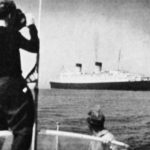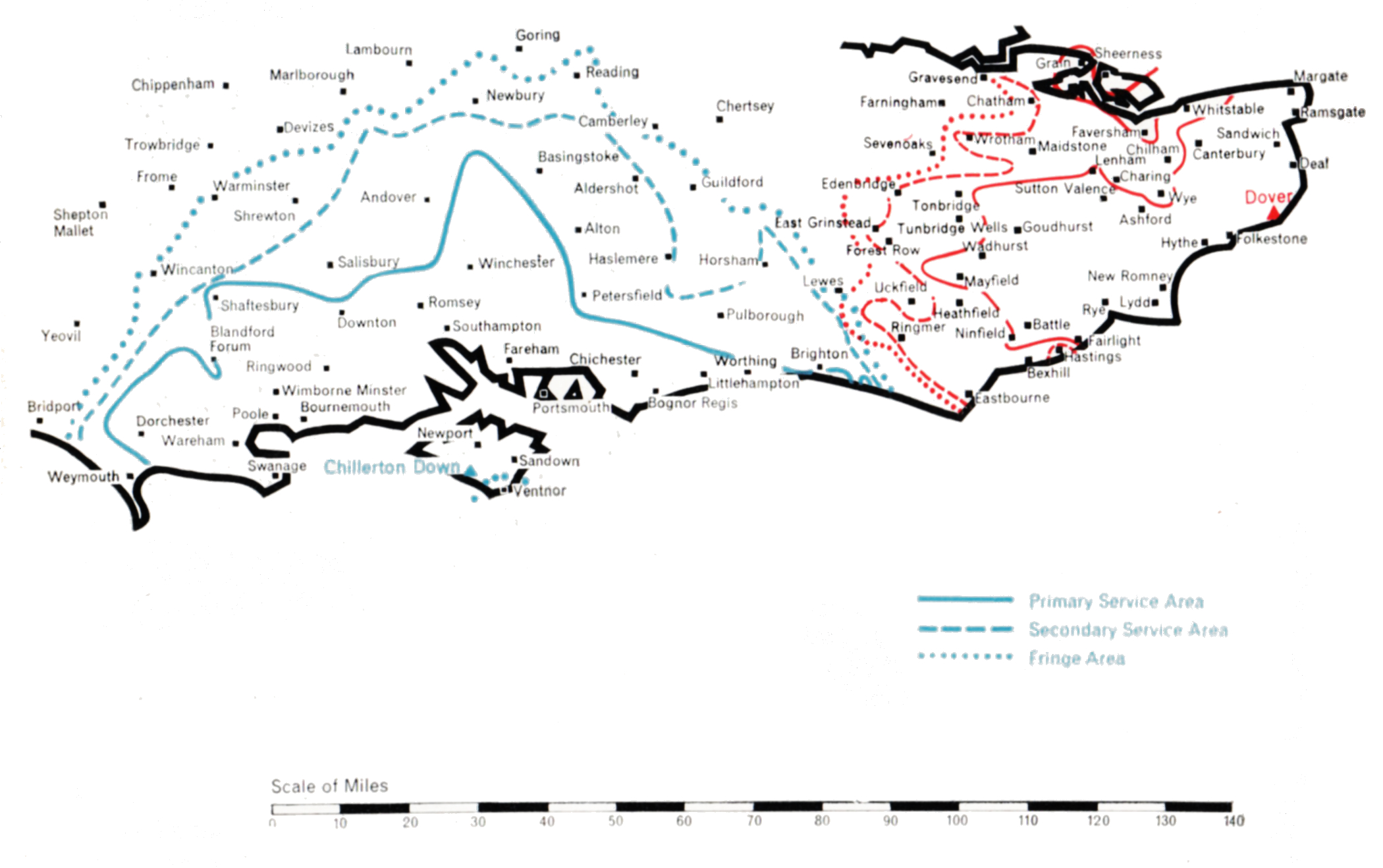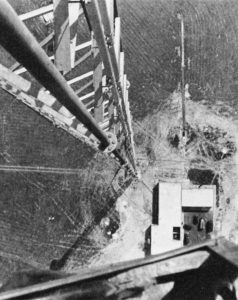Central Southern and South East-England

Southern Television Limited is a private company, whose shareholders are the Rank Organisation Limited (37½ per cent), Associated Newspapers Limited (37½ percent) and D.C. Thomson Limited (25 per cent). The company provides the Independent Television programmes for the Central-Southern area and the South-East area of England.
The Southern Television Centre, Northam, Southampton.
SOUTHAMPTON 28582/9
Glen House, Stag Place, Victoria, London S.W.1.
VICtoria 4404
Dover Studios, Russell Street, Dover
DOVER 2200/1
Area ITA Channel Vision Sound Opening Date Population ITA Homes
Transmitter Frequency Frequency 000's 000's
Mc/s Mc/s
Central Southern Chillerton Down 11 204.75 201.25 30th Aug 1958 }
} 4,269 836
South-East Dover 10 199.7135 196.1985 31st Jan 1960 }
Directors
John H Davis (Chairman); RA Redhead (Vice Chairman); CD Wilson, MC (Managing Director); The Rt Hon Lord Cornwallis of Linton, KBE, MC; GR Dowson; Donald Geddes; The Hon VHE Harmsworth; BG Henry (Sales Director); Sir Robert Perkins; R Rich (Controller of Programmes); BH Thomson. TD; DB Thomson; WH Thomson; Sir David Webster; K Winckles, MBE.
Officers
Berkeley Smith (Assistant Controller of Programmes); AF Jackman (Head of Programme Planning); LV Barnett (Publicity Manager); J Miell (General Sales Manager); GHY Grant, FCA (Secretary); RC Foord (Manager, Southampton); VG Hawkeswood (Chief Engineer).
Religious Advisers
The Venerable Michael Peck, Archdeacon of Portsmouth; The Reverend D Allen Smith, BSc; The Reverend Father G Dwyer.
Education Officer
FC Cross
Enquiries
Enquiries about artistes and programmes should be addressed to Viewers’ Correspondence, The Southern Television Centre, Northam, Southampton.
Programme Journal
TV Times publishes a Southern edition giving full details of the available programmes.
Educational Research
With the co-operation of Hampshire County Education Authority, Southern Television is sponsoring a three-year research programme in the use of closed-circuit television in schools, which started at the beginning of 1962. This controlled experiment is designed to investigate the further possibilities of employing closed-circuit television as an integral part of the normal work of a school and has been registered with the National Foundation for Educational Research as a project in educational research.
At the present time the experiment is confined to the Warblington County Secondary School at Havant but it is anticipated that it will eventually be extended to include another County Secondary School and possibly a Grammar School in the Havant area. The findings from this experiment will be announced from time to time.
Studios
THE SOUTHERN TELEVISION CENTRE, Northam, Southampton (Southampton 28582/9). Among the most up-to-date television centres in Britain, the three studios it houses are fully equipped and have a total working floor area of 3,830 sq. ft., comprising Studio A, 3,000 sq. ft.; Studio B, 660 sq. ft.; Studio C (News), 170 sq. ft. The total floor area for all technical facilities is 6,584 sq. ft. The technical areas associated directly with the three studios total 800 sq. ft. A separate building houses the outside broadcast vehicles, together with technical workshops and stores occupying 6,500 sq. ft. Master Control with its associated presentation studio covers 750 sq. ft. There are videotape recording facilities from two static Ampex VR 1,00 A machines and telecine facilities from four Cintel Flying Spot, multiplexed 35/16mm. machines, three with additional telejector facilities.
DOVER STUDIOS, Russell Street, Dover (Dover 2200/1). This studio of 1,125 sq. ft., with a control room of 457 sq. ft. and maintenance area of 225 sq. ft., is used for injecting items of direct interest to the South-East area into the existing programme structure.
Outside Broadcasts
Southern Television has a four-camera outside broadcast unit, comprising a mobile control room, tender, generator and mobile videotape recorder, together with three microwave-link vehicles.
Film Facilities
Two fully-equipped 16-mm. sound-film units, together with processing, editing and dubbing facilities.
Large-Screen Television
Southern Television has available equipment for cinema-screen-size projected television. This is available for hire by outside organisations. Enquiries should be made to the Chief Engineer.
Programmes
The programmes originated by Southern Television place great emphasis upon regional activities and events and are designed to appeal specifically to the people of the region which the company serves. Regular productions include: News and Current Affairs: Central Southern News and South-East News; Day by Day; Regional weather forecast service. Discussions and Documentaries: Background; Farm in the South; Come Gardening; Out of Town; Soldiers of the Queen. Variety and Light Entertainment: Beat Your Neighbour; Home Grown; Their Kind of Music. Children: Full Marks; What Do I See?. Religion: The Living Word; regular contributions to the networked Sunday Morning Services. Drama: Thirty Minute Theatre. Outside Broadcasts: regular coverage of topical and sporting events for the region and the ITV network, including some of the above programmes which are staged in towns throughout the region.
Local News Coverage
Regional news bulletins are transmitted every week-night at 6.05p.m. Separate simultaneous bulletins are broadcast for the Central Southern area over the ITA transmitter at Chillerton Down (I.O.W.) and for the South-East area over the Church Hougham (Dover) transmitter.
More than 150 news correspondents and film cameramen, as well as sound film units based at the Southampton and Dover studios, supply the newsroom and Day by Day team with film and news stories daily from all parts of the region.
Every evening, following the regional news, a staff meteorological office presents the weather forecast for the region. He prepares his material in co-operation with the Air Ministry Meteorological Office.



